Stochastic Models of the Social Security Trust Funds
Research and Statistics Note No. 2003-01 (released March 2003)
This note was prepared by Clark Burdick and Joyce Manchester, Division of Economic Research, Office of Research, Evaluation, and Statistics, Office of Policy. Research assistance provided by Eugene Bang.
The findings and conclusions presented in this paper are those of the authors and do not necessarily represent the views of the Social Security Administration.
Each year in March, the Board of Trustees of the Social Security trust funds reports on the current and projected financial condition of the Social Security programs. Those programs, which pay monthly benefits to retired workers and their families, to the survivors of deceased workers, and to disabled workers and their families, are financed through the Old-Age, Survivors, and Disability Insurance (OASDI) Trust Funds. In their 2003 report, the Trustees present, for the first time, results from a stochastic model of the combined OASDI trust funds.
Stochastic modeling is an important new tool for Social Security policy analysis and offers the promise of valuable new insights into the financial status of the OASDI trust funds and the effects of policy changes. This Research and Statistics (R&S) Note demonstrates that several stochastic models deliver broadly consistent results even though they use significantly different approaches and assumptions. However, the results also demonstrate that the variation in trust fund outcomes differs as the approach and assumptions are varied. Which approach and assumptions are best suited for Social Security policy analysis remains an open question. Further research is needed before the promise of stochastic modeling is fully realized. Despite this caveat, stochastic modeling results are already shedding new light on the range and distribution of trust fund outcomes that might occur in the future.
The stochastic model used in the Trustees' Report was recently developed by the Office of the Chief Actuary (OCACT) of the Social Security Administration to illustrate the uncertainty surrounding projections of the financial future of the Social Security system over the next 75 years. The stochastic results are intended to augment the traditional demonstrations of uncertainty used in past Trustees' Reports. The standard method of demonstrating uncertainty is to present three alternative sets of deterministic projections. The intermediate (Alternative II) projections are intended to reflect the best estimates of future experience. The low-cost (Alternative I) and high-cost (Alternative III) projections are based on more optimistic and more pessimistic assumptions about the future, respectively. The three alternatives indicate a possible range for future experience. The stochastic model also relies on the assumptions underlying the intermediate (Alternative II) projections. Time constraints dictated that the stochastic results in the 2003 Trustees' Report be based on the assumptions from the 2002 report.
The purpose of stochastic modeling is to further illustrate the degree of uncertainty inherent in projecting future financial outcomes for the combined OASDI trust funds. Those outcomes depend on the future values of a large number of demographic, economic, and program-specific variables that cannot be known with certainty and must be forecast. Stochastic modeling is an attempt to forecast the future values of variables in a manner that is consistent with contemporary economic and demographic theory and with empirical evidence. The statistical techniques used in stochastic modeling help to ensure that the variables that determine the future financial condition of the combined OASDI trust funds evolve over time in a fashion that is consistent with their past behavior and is intended to be consistent with their actual future behavior. Simulation techniques are used to construct a large number of future financial outcomes for the trust funds. Each simulation makes random draws for the stochastic variables from their assumed probability distributions and uses those randomly drawn variables to produce future trust fund outcomes. The distribution of those simulated outcomes is then assumed to be representative of the range and distribution of actual outcomes that might be realized in the future.
To help interpret the new stochastic results and to place them in context, the Social Security Administration's Office of Policy arranged for three external modeling groups to produce alternative stochastic results that also used the assumptions from the 2002 Trustees' Report.1 This R&S Note describes results produced by:
- The Congressional Budget Office Long Term (CBOLT) model;
- A model developed by Shripad Tuljapurkar and Ron Lee (TL), formerly of Mountain View Research; and
- The SSASIM model developed by the Policy Simulation Group.
The results from the three external models are analyzed and compared, with particular attention paid to the alternative assumptions and approaches adopted by each. The results are also compared with the stochastic results produced by OCACT and with the intermediate, high-cost, and low-cost projections traditionally used by the Trustees. The external models produce results that are quite similar to each other, but they exhibit some significant differences when compared with both the stochastic and nonstochastic results produced by OCACT.
Highlights of the Models' Results
The major results from the models are summarized below and in Table 1.
CBOLT Model
The median simulation result from the CBOLT model projects that the combined OASDI trust funds will be exhausted in 2037—4 years earlier than the date of 2041 projected under the Alternative II assumptions in the 2002 Trustees' Report. The CBOLT model projects a 10 percent chance that the trust funds will be exhausted by 2028, which is one year earlier than the Trustees' standard high-cost projection. The model also projects a 10 percent chance that exhaustion will not occur before 2063. In contrast, according to the Trustees' standard low-cost projection, the trust funds are not exhausted by 2076, the end of the 75-year projection period.
TL Model
The median simulation result from the TL model also projects exhaustion of the combined OASDI trust funds in 2037—again, 4 years earlier than projected by the standard model under the Alternative II assumptions in the 2002 Trustees' Report. The TL model projects a 10 percent chance that the trust funds will be exhausted by 2029 and a 10 percent chance that exhaustion might not occur before 2056. These dates compare with the high-cost projection of 2029 and the low-cost projection from the 2002 Trustees' Report that the trust funds will not be exhausted at the end of the 75-year projection period.
SSASIM Model
Although SSASIM is fully as capable as the other models, for this note it models only two variables stochastically—productivity and fertility. Therefore, the results from the SSASIM model shown here are not directly comparable with those of the other external models or with those produced by OCACT. Rather, the results are used to explore the implications of different modeling choices. The results show that stochastic modeling outcomes can exhibit significantly more variation when structural time-series models are used than when the more typical reduced-form ARIMA models are used. The limited SSASIM model produces median simulation results that project exhaustion of the trust funds in 2037 and 2038 under the two different model specifications, respectively. Again, these dates are 3 to 4 years earlier than the date of 2041 projected under the intermediate assumptions in the 2002 Trustees' Report.
OCACT Model
Unlike the results of the three external models, the OCACT stochastic projections produce a median simulation result of trust fund exhaustion in 2041, the same as the standard Alternative II projection. The OCACT results indicate a 10 percent chance that the combined OASDI trust funds will be exhausted by 2034 and a 10 percent chance that they will not be exhausted before 2057.
| Model | Low range | Intermediate range | High range |
|---|---|---|---|
| Stochastic models | |||
| CBOLT | 2028 | 2037 | 2063 |
| TL | 2029 | 2037 | 2056 |
| SSASIM | a | 2037/2038 | a |
| OCACT | 2034 | 2041 | 2057 |
| Standard model (Trustees' Report) | 2029 | 2041 | b |
| NOTE: For the stochastic models, the low-, intermediate-, and high-range results are for the 10th, 50th, and 90th percentile, respectively. For the Trustees' Report, the three ranges are for the low-cost, intermediate, and high-cost assumptions in the 2002 Trustees' Report. | |||
| a. For this note, SSASIM modeled only two variables—productivity and fertility—stochastically, so the range of outcomes should not be compared with those of the other stochastic models. | |||
| b. According to the low-cost projections in the 2002 Trustees' Report, the trust funds are not exhausted at the end of the 75-year projection period. | |||
All three external models produce median simulation results that project that the combined OASDI trust funds will be exhausted 3 to 4 years earlier than projected under Alternative II in the 2002 Trustees' Report. By contrast, the OCACT median simulation results show trust fund exhaustion in the same year as Alternative II. Differences in the short-run behavior of the input variables and in the methodology used in modeling the long-run behavior of some variables may account for the divergent results, as explained below.
The trust fund ratio (TFR), or the ratio of trust fund assets at the beginning of the year to the year's expenditures, is a common measure of financial adequacy for the OASDI trust funds. The TFR projections from the CBOLT, TL, and OCACT stochastic models are detailed in the fan charts shown below (see Chart 1). The projections from the SSASIM model are shown later since, for this note, the SSASIM model was restricted to modeling only two variables—productivity and fertility—stochastically, producing results not directly comparable with those of the other models.2
Trust fund ratio projections from the CBOLT, TL, and OCACT stochastic models
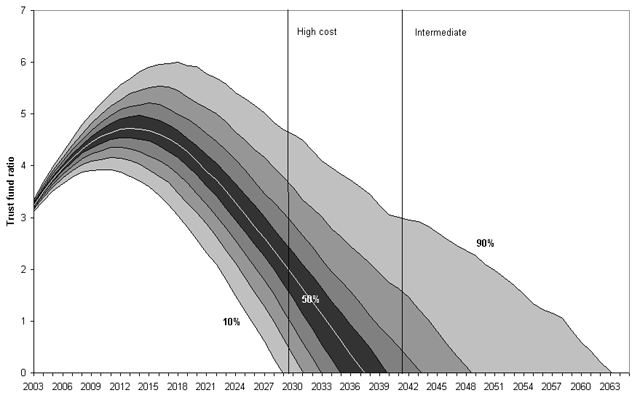
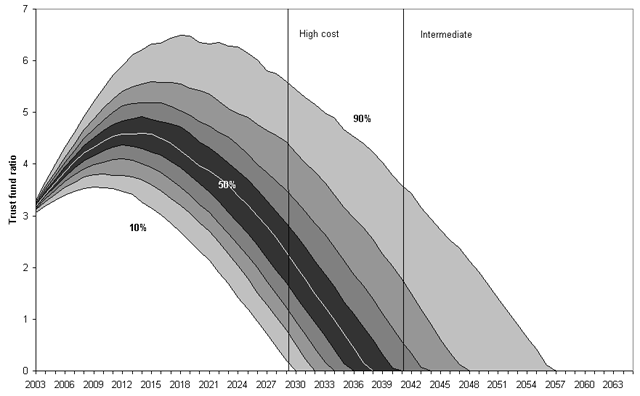
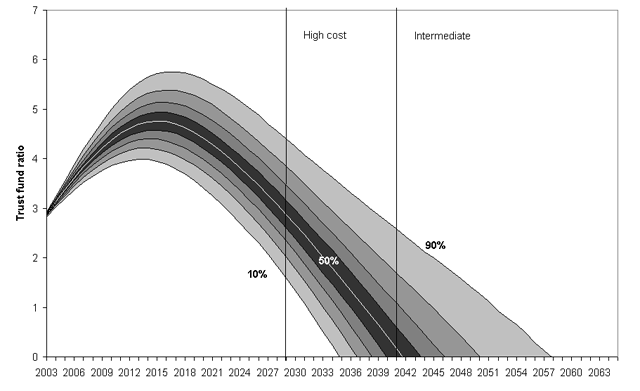
The fan charts depict the 10th through the 90th percentiles of the simulation results. The percentiles do not represent individual simulation outcomes or paths. Rather, they describe the probability distribution of all of the simulation outcomes collectively. In each year, 10 percent of the simulated TFRs fall below the 10th percentile, another 10 percent fall between the 10th and 20th percentiles, and so on. Finally, 10 percent of the simulated TFRs for each year lie above the 90th percentile. The fan charts are assumed to describe the probability distribution of future TFR outcomes that might be realized.
When the trust fund reaches zero, the combined OASDI trust funds are exhausted. Exhaustion dates shown in the fan charts match those in Table 1. In addition, the fan charts illustrate differences in how the various models depict the evolution of the trust funds over time.
Assumptions
The standard low-cost, intermediate, and high-cost projections described in the Trustees' Report are each based on a set of assumptions for the variables that determine the financial future of the combined OASDI trust funds. Each set of assumptions consists of a short-range path and a long-range ultimate value for each variable. Those assumptions are agreed upon each year by the Trustees of the OASDI trust funds. The intermediate assumptions reflect the Trustees' best estimate for the future behavior of each variable. The new stochastic model developed by OCACT uses the intermediate assumptions as the mean, or expected value, of each of the stochastic variables.
The External Models
The external models also use the ultimate assumptions of Alternative II in the 2002 Trustees' Report as the long-run expected value of the stochastic variables, with one exception. The TL model uses a method known as Lee-Carter to simulate future mortality. The Lee-Carter approach generates faster mortality improvement, resulting in longer life expectancies, than do the Trustees' 2002 intermediate assumptions about mortality.
The CBOLT and SSASIM methods for simulating future economic variables are similar to each other.3 Both models use a three-variable system of equations to simulate inflation, unemployment, and interest rates. The two models differ in that the CBOLT model simulates the real (inflation-adjusted) interest rate whereas the SSASIM model simulates nominal interest rates. In addition, the CBOLT model adds an equation describing real wage growth, while the SSASIM model adds an equation for productivity growth. In contrast, the TL model adopts a different, reduced-form approach, modeling the real interest rate and the rate of real wage growth in separate equations and focusing on the effective real per capita tax rate without modeling unemployment and inflation directly.4
Despite their different approaches, the CBOLT and TL models produce stochastic projections that are broadly similar. The median results of both models project the same date of 2037 for trust fund exhaustion, 4 years sooner than projected under Alternative II in the 2002 Trustees' Report. The SSASIM model produces median trust fund exhaustion dates of 2037 and 2038 for the two different model specifications considered. Again, these dates are 3 to 4 years earlier than projected under the Alternative II assumptions from the 2002 Trustees' Report.
The OCACT Model
The assumptions regarding the behavior of stochastic variables in the OCACT model differ somewhat from those of the external models. The expected values of OCACT's input variables are calibrated to the Alternative II short-range assumptions for up to 25 years before settling into the Alternative II ultimate values (the CBOLT model also follows this approach). In addition, whereas the OCACT model projects the level of the variables, the external models in many cases project a nonlinear function of a variable (for example, the logarithm of the variable). In the external models, those projected nonlinear functions lead to asymmetric responses to shocks, which cause the median projections of the trust fund ratio to lie below the Alternative II projection. Using levels rather than nonlinear functions may contribute to the OCACT model's tracking the Alternative II projections of the trust fund ratio more closely.
Modeling Approaches Examined in the SSASIM Model
As mentioned above, the results from the SSASIM model are not directly comparable with those of the CBOLT and TL models. The SSASIM results do, however, highlight the importance of basic approaches when modeling the OASDI trust funds stochastically.
The model generates two sets of results, using two different specifications for the behavior of the stochastic variables. The results indicate greater dispersion of outcomes when a structural time-series specification is assumed for the stochastic variables. The structural time-series approach allows the behavior of stochastic variables to change over time. The more common reduced-form ARIMA specification for the stochastic variables produces less dispersion of outcomes. Such a result is expected because the ARIMA modeling approach assumes that the behavior of stochastic variables does not change over time. The structural time-series approach may produce a better fit to the historical data for some variables. The trust fund ratio projections from the SSASIM model under both approaches are shown in Chart 2.
Comparison of trust fund ratio projections from the SSASIM model
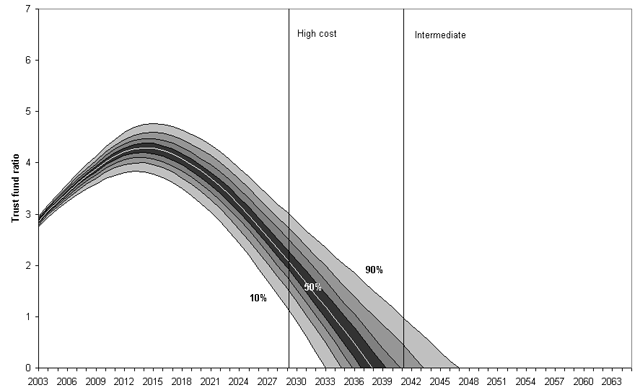
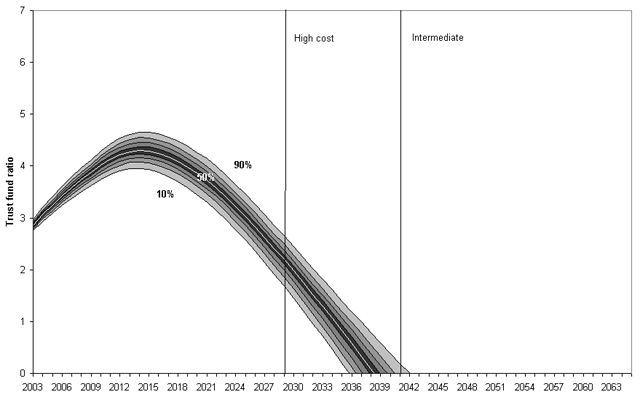
Additional Modeling Issues
The results from the three external models differ because of the varying approaches they adopt and the varying assumptions each model makes. However, all three models have been carefully calibrated so that in the long run the expected values of stochastic variables, with the exception of mortality in the TL model, are in accord with the Alternative II assumptions from the 2002 Trustees' Report. Hence, the results are conditional on the Alternative II assumptions. To eliminate this strict reliance on those assumptions, the ultimate rates to which the stochastic variables are calibrated can themselves be treated stochastically. Incorporating stochastic ultimate rates will add an additional dimension of uncertainty to the models, resulting in greater dispersion of the trust fund outcomes (Holmer 2003).
Yet another dimension of uncertainty concerns the parameter values used in the simulation of future values of the stochastic variables. Each of the models estimates its time-series equations using historical data. Once estimated, the coefficients are treated as if they are known with certainty. However, an alternative statistical approach would treat these estimated coefficients themselves as random, adding additional uncertainty to the stochastic models and resulting in still greater dispersion of the trust fund outcomes (Lee and Carter 1992).
Notes
1. An earlier version of the CBOLT model was documented in Congressional Budget Office (2001). Results from the TL model are documented in Lee, Anderson, and Tuljapurkar (2003). Those from the SSASIM model are described in Holmer (2003).
2. Previous results from the SSASIM model (Holmer 2002) that exploit its full stochastic capabilities have produced projections that are broadly similar to those of the CBOLT and TL models in all respects.
3. For this note, the SSASIM model was restricted to modeling only two variables---productivity and fertility---stochastically. Nevertheless, the SSASIM model has the ability to model all of the major trust fund determinants stochastically and is fully as capable as the other models described in this note. It is these more general capabilities that are referred to here.
4. The TL modeling team chose this approach after finding statistical evidence that the real interest rate and real wage growth are independent.
References
Board of Trustees of the Federal Old-Age and Survivors Insurance and Disability Insurance Trust Funds. 2002. 2002 Annual Report. Washington, D.C.: U.S. Government Printing Office. March. Available at http://www.ssa.gov/OACT/TR/TR02/index.htm.
__________. 2003 Annual Report. Washington, D.C.: U.S. Government Printing Office. March. Available at http://www.ssa.gov/OACT/TR/TR03/index.html.
Congressional Budget Office. 2001. Uncertainty in Social Security's Long-Term Finances: A Stochastic Analysis. Technical Report. December. Available at http://www.cbo.gov.
Holmer, Martin R. 2002. Presentation to Office of Policy, Social Security Administration, Washington, D.C. June.
__________. 2003. Methods for Stochastic Trust Fund Projection. Report prepared for the Social Security Administration. January. Available at http://www.polsim.com/stochsim.pdf.
Lee, Ronald D., and Lawrence Carter. 1992. "Modeling and Forecasting the Time Series of U.S. Mortality." Journal of the American Statistical Association 87(419): 659-671.
Lee, Ronald D., Michael W. Anderson, and Shripad Tuljapurkar. 2003. Stochastic Forecasts of the Social Security Trust Fund. Report prepared for the Social Security Administration. January.